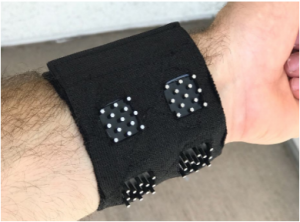 Millions of people rely on wearable medical technology such as hearing aids, glucose monitors, insulin pumps, and portable heart rate monitors. Some of these technologies are lifesaving, but keeping them powered can be a source of stress. Before a wearer does anything outside the home, they have to worry about whether their devices’ batteries need charging or replacing, which can seriously limit them from doing things like camping or other longer outdoor activities.
Millions of people rely on wearable medical technology such as hearing aids, glucose monitors, insulin pumps, and portable heart rate monitors. Some of these technologies are lifesaving, but keeping them powered can be a source of stress. Before a wearer does anything outside the home, they have to worry about whether their devices’ batteries need charging or replacing, which can seriously limit them from doing things like camping or other longer outdoor activities.
A group of students from Santa Clara University have developed a wearable biosensor that relies on thermoelectric power. The partially 3D printed wristband prototype uses body heat, ambient air and heat sinks to create a temperature difference across thermoelectric modules, which generates extremely low voltage electrical power. A boost converter boosts the voltage to the level required by medical device batteries.
“Our goal was to use this generated power to charge medical device batteries off-the-grid, increasing medical device user freedom and allowing medical device access to those without electricity,” the researchers explain. “We successfully constructed a wearable prototype that generates the voltage required by an electrocardiogram battery; however, further thermoelectric module and heat dissipation optimization is necessary to generate sufficient current to charge the battery.”
The students also point out that 13% of the world’s population lives without access to electricity, meaning that they don’t have access to electronic medical devices that need to be regularly charged. A thermoelectric-powered medical device has yet to make it to market, but the prototype developed by the students is a promising one.
The main function of the device is to convert a temperature difference created by body heat and ambient air into a voltage output sufficient to charge the battery of a wearable EKG or another low-input medical device. It consists of four subsystems: power generation, voltage boost, battery charging and wearability.
3D printing was used to create the housing for the thermoelectric modules, namely a Formlabs Form 2 3D printer. The housing may be the most important part of the design – the students identify it as the basis for their patentable design.
“Our housing uniquely fastens together a thermoelectric module and heat sink using 3D printed plastic,” the students state. “The novel portions of our design include the ridges used to hold the heat sink in place, bars for easy connectability in series or parallel patterns, and the robustness of the housing which protects and electrically insulates delicate thermoelectric module leads.”
3D printing was chosen because it allowed for the time between each iteration to be greatly reduced, and the material was strong and durable enough to withstand impacts and protect the components inside. The wristband works using body heat from the wrist, which heats up the bottom of the thermoelectric modules, while heat sinks dissipate heat away from the top of the modules. The temperature difference across the modules creates electricity, which is boosted using a boost converter.
The paper goes on to explain in more detail how temperature is used to power the device and eliminate the need for any kind of external charging or power source. You can read the full paper, entitled “Powering a Biosensor Using Wearable Thermoelectric Technology,” here.
It seems almost like a simple idea, and it’s surprising that no medical device like this has yet reached the market. If a device like this does make it to market, it could make a huge difference in the lives of millions of people. Batteries may never be eliminated as a necessary technology, but in terms of wearable medical devices, using temperature to power them could be the future.
Authors of the paper include Anneliese Bals, Noah Barnes, Rafael Bravo, Nicholas Garcia, Joseph O’Bryan, and Dylan Santana.
Discuss this and other 3D printing topics at 3DPrintBoard.com or share your thoughts below.
Subscribe to Our Email Newsletter
Stay up-to-date on all the latest news from the 3D printing industry and receive information and offers from third party vendors.
Print Services
Upload your 3D Models and get them printed quickly and efficiently.
You May Also Like
The Market and Industry Potential of Multi-Material 3D and 4D Printing in Additive Electronics
Additive manufacturing leverages computer-based software to create components for products by depositing either dielectric or conductive materials, layer by layer, into different geometric shapes. Since its birth in the 1980s,...
3DPOD 262: Bio-inspired Design for AM with Dhruv Bhate, Arizona State University
Dhruv Bhate is an associate professor at Arizona State University. There, he looks at structures, materials, and design. Previously, he worked at PADT as well as in the semiconductor and...
3DPOD 261: Tooling and Cooling for AM with Jason Murphy, NXC MFG
Jason Murphy´s NXC MFG (Next Chapter Manufacturing) is not a generalist service; instead, the company specializes in making tooling. Using LPBF and binder jet, the company produces some of the...
3DPOD 260: John Hart on VulcanForms, MIT, Desktop Metal and More
John Hart is a Professor at MIT; he´s also the director of the Laboratory for Manufacturing and Productivity as well as the director of the Center for Advanced Production Technologies....


































